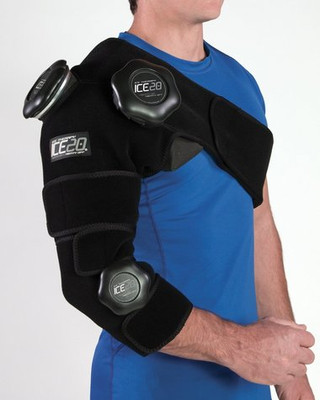 9th Aug 2018
9th Aug 2018
How to Improve Recovery for Post-Surgery Shoulder Patients
For patients who need to undergo surgical repair for a shoulder injury are concerned with returning to normal function in their day-to-day activities. The need to wear a sling and modifying most daily activities can inhibit most people who have busy schedules and lives. However, pushing too fast puts these surgical shoulder patients at a higher risk for recurrent injury. Additionally, physical therapy can help hasten recovery and improve long term outcomes for these patients, giving them the ability to resume their normal activities that much faster.
Physical therapists can educate and modify activities for patients as well as utilize specific modalities which can help address post-surgical pain, edema and reduced range of motion associated with a surgical procedure.
Post-Surgical Shoulder Recovery Risks
A comprehensive recovery barring complications and subsequent infection is important for the success of any surgical procedure. There are specific risks that should be addressed to improve a patient’s outcome following shoulder surgery. Some of these risks include: lack of patient compliance, doing exercises incorrectly, and doing certain activities too soon.
Patient Compliance
Recovery following from shoulder surgery can be painful and slow-going, even for the patients who are extremely motivated to participate fully in their physical therapy regimens. There are times when patients may feel like they’re not progressing and will begin to delay or stop doing their assigned home exercises. Making sure patients understand the importance of each exercise and the need for compliance will go a long way towards having them complete their home exercise programs. Additionally, using modalities like cold compression therapy which can help alleviate triggered pain quickly will help increase their comfort and improve the likelihood of compliance. The cold compression therapy wrap from ICE is a great choice because it is ergonomically designed for use on the shoulder.
Maintaining Proper Alignment
Therapeutic exercise is only beneficial when patients are able to maintain proper alignment while executing their physical therapy exercises. Because exercise can cause recurrent injury or trigger pain, it’s important that patients have their therapeutic exercise overseen by a physical therapist. What’s more, it can therapeutic exercise is a culprit in triggered pain.
Modalities like cold compression therapy is a great modality to use after therapeutic exercise. The cold therapy offers an analgesic benefit helping to reduce pain fast, while the compression effectively moves any swelling away from the injured area. This combination will help to reduce tenderness and improve function.
Overuse
While a lot of shoulder injuries can be due to overuse, patients are also at risk for injury following their shoulder surgery if they try to do too much too soon. This will not only impede their recovery, but it puts them at a high risk for a reinjury. Education is key so that patients understand just how much weight they can bear and how many repetitions are beneficial.
If a patient over does it following shoulder surgery, they could lengthen their recovery, do permanent damage or create the need for an additional surgery. Pre-emptively treating triggered pain during treatment sessions with modalities like cold therapy using ice packs or cold compression, will go a long way towards helping reduce the impact of overuse.
Post-Shoulder Surgery Physical Therapy Modalities
In addition to the appropriate exercises for the type of injury, type of surgery, and other patient-specific factors, there are a number of methods practitioners can offer to help patients get back normal function in their favorite activities.
The Best Modalities to Use with Post-Shoulder Surgery Patients
Cold and Compression Therapy
Most post-surgical shoulder patients will experience
- Inflammation and edema
- Pain and tenderness
- Reduced range of motion
One of the easiest ways for practitioners to address these symptoms quickly is by using a modality that can offer benefits for all three. Cold compression therapy has been shown to help manage symptoms following orthopedic surgery for musculoskeletal injuries. According to a study published in the Open Access Journal of Sports Medicinecold and compression used immediately after surgery helps reduce pain, reduce swelling and speed functional recovery.
The benefit of using a cold compression unit is it provides a consistent cold temperature that lasts much longer than a therapeutic ice pack. Add to the active compression, the cold therapy is able to penetrate deeper in the treated area as well as aid in the reduction of swelling. The ICE body-conforming wrap delivers cold therapy at every angle of the shoulder.
Contrast Therapy
Contrast therapy also known as hot/cold immersion therapy alternates between the use of therapeutic heat and cold therapy to optimize the benefits of each modality. When used together, contrast therapy can help increase the circulation of the shoulder post-surgery which helps reduce inflammation. Not only that, but contrast therapy also works to improve recovery outcomes because it brings fresh nutrients and oxygenated blood to the injured tissues.
An easy way to offer contrast therapy is the use of hot packs combined with cold compression therapy. Timing of treatment can vary depending on patient’s needs: at the beginning of treatment for acute pain, at the end of treatment for triggered and/or radiating pain.
Therapeutic Exercise Equipment
In addition to pain relieving modalities, it’s important to add therapeutic exercise which requires the muscles in the shoulder joint to safely engage and move within the full range of motion. This will help prevent stiffness and encourage greater range of motion post-recovery. Devices like an Active/Passive exercise trainer is a great choice to achieve these aims, because it enables gentle movement and can improve range of motion for patients who can’t reach end range on their own..
Successful recovery following shoulder surgery requires the use of targeted modalities like cold compression to address symptoms from surgery as well as devices and equipment like that can improve strength and functional movement.
Contact us today!
We can help your practice find the perfect cold compression devices for your post-surgical patients. Contact us today and we’ll answer any questions you may have about the benefits of cold-compression therapy in rehabilitation! Call us today at 1-801-770-3328 for more information.






